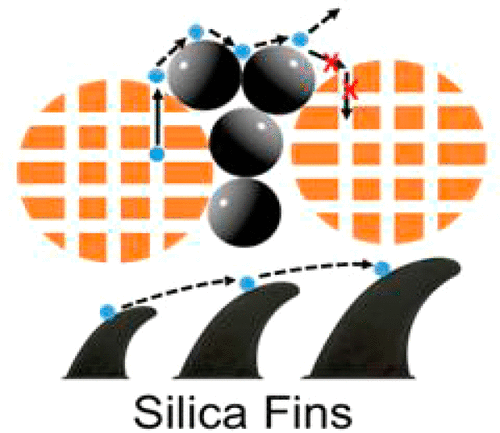当前位置:
X-MOL 学术
›
Chem. Mater.
›
论文详情
Our official English website, www.x-mol.net, welcomes your
feedback! (Note: you will need to create a separate account there.)
Silica Nanoparticle Mass Transfer Fins for MFI Composite Materials
Chemistry of Materials ( IF 7.2 ) Pub Date : 2018-03-20 00:00:00 , DOI: 10.1021/acs.chemmater.7b05400 Xiaoduo Qi 1 , Vivek Vattipalli 1 , Paul J. Dauenhauer 2 , Wei Fan 1
Chemistry of Materials ( IF 7.2 ) Pub Date : 2018-03-20 00:00:00 , DOI: 10.1021/acs.chemmater.7b05400 Xiaoduo Qi 1 , Vivek Vattipalli 1 , Paul J. Dauenhauer 2 , Wei Fan 1
Affiliation

|
Zeolite nanoparticles have been widely used to overcome diffusion limitations in heterogeneous catalytic reactions. However, the existence of surface barriers for molecular diffusion in zeolites can limit the benefits of using nanoparticles in catalytic reactions. In this study, a set of silica nanoparticle (SNP)/silicalite-1 composites with different external surface to micropore surface ratios was synthesized to understand the effects of surface-controlled mass transport on molecular diffusion in zeolite nanoparticles. The zero length column (ZLC) technique was used to evaluate the mass transport of cyclohexane in these materials. It was found that the strong sorbate/sorbent interaction at the external surface of silicalite-1 nanoparticles can cause diffusing molecules to re-enter into micropores and repeat the micropore diffusion process. This pore re-entry step can lead to an unusually long micropore diffusion length. We also demonstrated that this repeated micropore diffusion process can be effectively reduced by mixing the zeolite nanoparticles with secondary, nonporous nanoparticles. This study provides an alternative way to justify the surface mass transfer resistance, and it also introduces a simple strategy to enhance mass transport in zeolite nanoparticles other than surface modification which can damage the integrity of zeolite crystals. Additionally, previous diffusion results were revisited by adjusting the actual micropore diffusion length. It was concluded that the surface resistance in zeolite nanoparticles is likely due to a combination of pore re-entry of adsorbates and pore blockage.
中文翻译:

用于MFI复合材料的二氧化硅纳米颗粒传热鳍片
沸石纳米颗粒已被广泛用于克服非均相催化反应中的扩散限制。然而,用于分子在沸石中扩散的表面屏障的存在会限制在催化反应中使用纳米颗粒的益处。在这项研究中,合成了一组具有不同的外表面与微孔表面比率的二氧化硅纳米粒子(SNP)/ silicalite-1复合材料,以了解表面控制质量传输对分子在沸石纳米粒子中扩散的影响。零长度色谱柱(ZLC)技术用于评估这些材料中环己烷的质量传递。发现在silicalite-1纳米颗粒的外表面上的强吸附剂/吸附剂相互作用可引起扩散分子重新进入微孔并重复微孔扩散过程。该孔重新进入步骤可导致异常长的微孔扩散长度。我们还证明,通过将沸石纳米颗粒与次级,无孔纳米颗粒混合,可以有效地减少这种重复的微孔扩散过程。这项研究提供了另一种方法来证明表面传质阻力的合理性,并且还引入了一种简单的策略来增强沸石纳米颗粒中的传质,而不是进行表面改性,因为这可能会破坏沸石晶体的完整性。另外,通过调节实际的微孔扩散长度可以重新考虑以前的扩散结果。结论是,沸石纳米颗粒的表面电阻很可能是由于吸附物的孔隙再进入和孔隙堵塞的结合。我们还证明,通过将沸石纳米颗粒与次级,无孔纳米颗粒混合,可以有效地减少这种重复的微孔扩散过程。这项研究提供了另一种方法来证明表面传质阻力的合理性,并且还引入了一种简单的策略来增强沸石纳米颗粒中的传质,而不是进行表面改性,因为这可能会破坏沸石晶体的完整性。另外,通过调节实际的微孔扩散长度可以重新考虑以前的扩散结果。结论是,沸石纳米颗粒的表面电阻很可能是由于吸附物的孔隙再进入和孔隙堵塞的结合。我们还证明,通过将沸石纳米颗粒与次级,无孔纳米颗粒混合,可以有效地减少这种重复的微孔扩散过程。这项研究提供了另一种方法来证明表面传质阻力的合理性,并且还引入了一种简单的策略来增强沸石纳米颗粒中的传质,而不是进行表面改性,因为这可能会破坏沸石晶体的完整性。另外,通过调节实际的微孔扩散长度可以重新考虑以前的扩散结果。结论是,沸石纳米颗粒的表面电阻很可能是由于吸附物的孔隙再进入和孔隙堵塞的结合。这项研究提供了另一种方法来证明表面传质阻力的合理性,并且还引入了一种简单的策略来增强沸石纳米颗粒中的传质,而不是进行表面改性,因为这可能会破坏沸石晶体的完整性。另外,通过调节实际的微孔扩散长度可以重新考虑以前的扩散结果。结论是,沸石纳米颗粒的表面电阻很可能是由于吸附物的孔隙再进入和孔隙堵塞的结合。这项研究提供了另一种方法来证明表面传质阻力的合理性,并且还引入了一种简单的策略来增强沸石纳米颗粒中的传质,而不是进行表面改性,因为这可能会破坏沸石晶体的完整性。另外,通过调节实际的微孔扩散长度可以重新考虑以前的扩散结果。结论是,沸石纳米颗粒的表面电阻很可能是由于吸附物的孔隙再进入和孔隙堵塞的结合。通过调整实际的微孔扩散长度可以重新考虑以前的扩散结果。结论是,沸石纳米颗粒的表面电阻很可能是由于吸附物的孔隙再进入和孔隙堵塞的结合。通过调整实际的微孔扩散长度可以重新考虑以前的扩散结果。结论是,沸石纳米颗粒的表面电阻很可能是由于吸附物的孔隙再进入和孔隙堵塞的结合。
更新日期:2018-03-20
中文翻译:

用于MFI复合材料的二氧化硅纳米颗粒传热鳍片
沸石纳米颗粒已被广泛用于克服非均相催化反应中的扩散限制。然而,用于分子在沸石中扩散的表面屏障的存在会限制在催化反应中使用纳米颗粒的益处。在这项研究中,合成了一组具有不同的外表面与微孔表面比率的二氧化硅纳米粒子(SNP)/ silicalite-1复合材料,以了解表面控制质量传输对分子在沸石纳米粒子中扩散的影响。零长度色谱柱(ZLC)技术用于评估这些材料中环己烷的质量传递。发现在silicalite-1纳米颗粒的外表面上的强吸附剂/吸附剂相互作用可引起扩散分子重新进入微孔并重复微孔扩散过程。该孔重新进入步骤可导致异常长的微孔扩散长度。我们还证明,通过将沸石纳米颗粒与次级,无孔纳米颗粒混合,可以有效地减少这种重复的微孔扩散过程。这项研究提供了另一种方法来证明表面传质阻力的合理性,并且还引入了一种简单的策略来增强沸石纳米颗粒中的传质,而不是进行表面改性,因为这可能会破坏沸石晶体的完整性。另外,通过调节实际的微孔扩散长度可以重新考虑以前的扩散结果。结论是,沸石纳米颗粒的表面电阻很可能是由于吸附物的孔隙再进入和孔隙堵塞的结合。我们还证明,通过将沸石纳米颗粒与次级,无孔纳米颗粒混合,可以有效地减少这种重复的微孔扩散过程。这项研究提供了另一种方法来证明表面传质阻力的合理性,并且还引入了一种简单的策略来增强沸石纳米颗粒中的传质,而不是进行表面改性,因为这可能会破坏沸石晶体的完整性。另外,通过调节实际的微孔扩散长度可以重新考虑以前的扩散结果。结论是,沸石纳米颗粒的表面电阻很可能是由于吸附物的孔隙再进入和孔隙堵塞的结合。我们还证明,通过将沸石纳米颗粒与次级,无孔纳米颗粒混合,可以有效地减少这种重复的微孔扩散过程。这项研究提供了另一种方法来证明表面传质阻力的合理性,并且还引入了一种简单的策略来增强沸石纳米颗粒中的传质,而不是进行表面改性,因为这可能会破坏沸石晶体的完整性。另外,通过调节实际的微孔扩散长度可以重新考虑以前的扩散结果。结论是,沸石纳米颗粒的表面电阻很可能是由于吸附物的孔隙再进入和孔隙堵塞的结合。这项研究提供了另一种方法来证明表面传质阻力的合理性,并且还引入了一种简单的策略来增强沸石纳米颗粒中的传质,而不是进行表面改性,因为这可能会破坏沸石晶体的完整性。另外,通过调节实际的微孔扩散长度可以重新考虑以前的扩散结果。结论是,沸石纳米颗粒的表面电阻很可能是由于吸附物的孔隙再进入和孔隙堵塞的结合。这项研究提供了另一种方法来证明表面传质阻力的合理性,并且还引入了一种简单的策略来增强沸石纳米颗粒中的传质,而不是进行表面改性,因为这可能会破坏沸石晶体的完整性。另外,通过调节实际的微孔扩散长度可以重新考虑以前的扩散结果。结论是,沸石纳米颗粒的表面电阻很可能是由于吸附物的孔隙再进入和孔隙堵塞的结合。通过调整实际的微孔扩散长度可以重新考虑以前的扩散结果。结论是,沸石纳米颗粒的表面电阻很可能是由于吸附物的孔隙再进入和孔隙堵塞的结合。通过调整实际的微孔扩散长度可以重新考虑以前的扩散结果。结论是,沸石纳米颗粒的表面电阻很可能是由于吸附物的孔隙再进入和孔隙堵塞的结合。











































 京公网安备 11010802027423号
京公网安备 11010802027423号